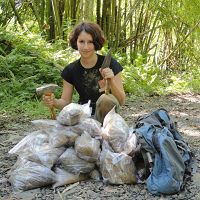Stone & Plante, 2014
Changes in phosphatase kinetics with soil depth across a variable tropical landscape.
Stone, M.M., Plante, A.F. (2014)
Soil Biology & Biochemistry
-
Christina, Luquillo, INVESTIGATOR, COLLABORATOR
-
Luquillo, GRAD STUDENT
Abstract
Phosphatase enzymes play a key role cycling phosphorus from organic to plant-available pools, particularly in tropical soils where inorganic phosphorus is often limited. However, most studies of phosphatase activity have focused only on surface soils, despite the large quantities of carbon and nutrients stored in tropical subsoils. The goal of this study was to determine how acid phosphatase kinetic parameters change with depth across two parent materials (represented by Oxisols and an Inceptisols) and two distinct forests (lower and upper montane) at the Luquillo Critical Zone Observatory in northeast Puerto Rico. We collected samples from five soil pits at each of four soil forest types, and measured apparent phosphatase kinetic parameters (AppVmax and AppKm) and soil nutrients at 0, 20, 50, 80, 110 and 140 cm depths. Across all sites, AppVmax declined 97% and AppKm declined 85% from the surface to 140 cm depth. The ratio of AppVmax to AppKm (i.e., Ka) did not change through the first meter of soil profiles but was significantly reduced by 50% 140 cm. Total carbon, nitrogen and extractable phosphorus all declined exponentially with depth. Carbon concentrations and AppVmax were both significantly greater in Oxisols compared with Inceptisols, and in the higher elevation montane forest compared to the lower elevation forest. The scaling relationship we observe between AppVmax and AppKm is common for environmental systems, although the degree of correlation in our study (R2 = 0.48) is unusually high, suggesting these parameters are both driven by changes in energy and nutrient availability along depth profiles. However, the consistency of Ka with depth indicates that overall catalytic capacity of phosphatase is maintained across a range of substrate concentrations. The larger variability in AppVmax compared with AppKm suggests microorganisms exert more control over phosphatase production than substrate availability. Our findings indicate that subsoil microbial communities are not metabolically dormant, but rather contribute to P-cycling at rates comparable to their surface counterparts. Further research on ecology of microorganisms in resource-limited tropical subsoils is warranted to better understand microbial contributions to biogeochemical cycles throughout tropical soil profiles.
Keywords: acid phosphatase, phosphorus, enzyme kinetics, tropical subsoil, Luquillo
Citation
Stone, M.M., Plante, A.F. (2014): Changes in phosphatase kinetics with soil depth across a variable tropical landscape. Soil Biology & Biochemistry. DOI: 10.1016/j.soilbio.2014.01.006
 This Paper/Book acknowledges NSF CZO grant support.
This Paper/Book acknowledges NSF CZO grant support.
Explore Further


